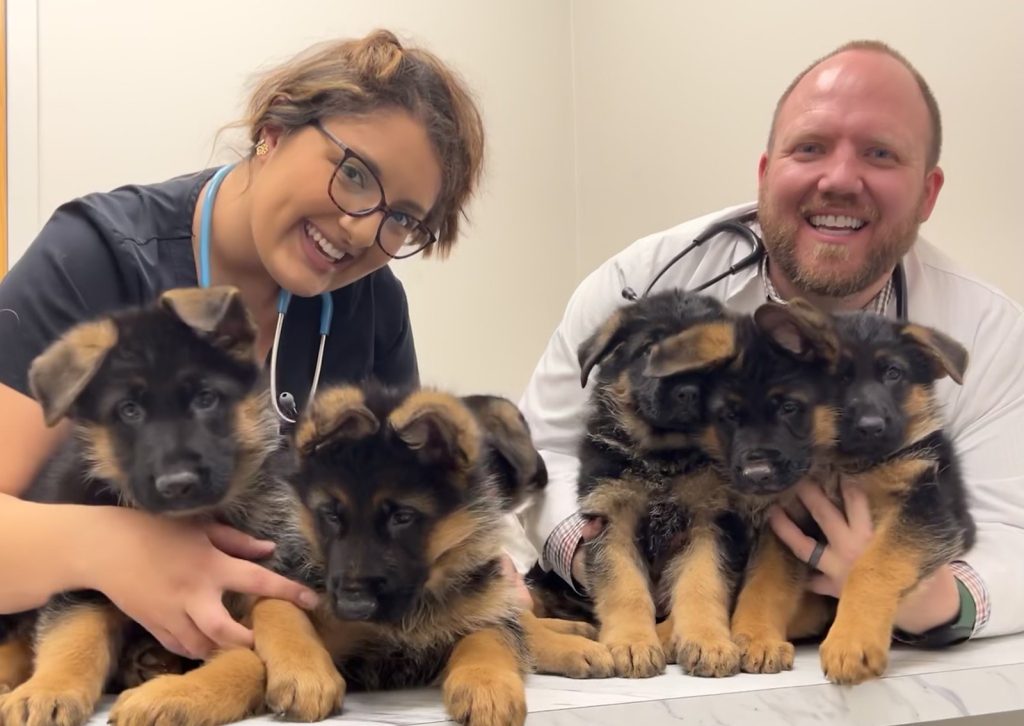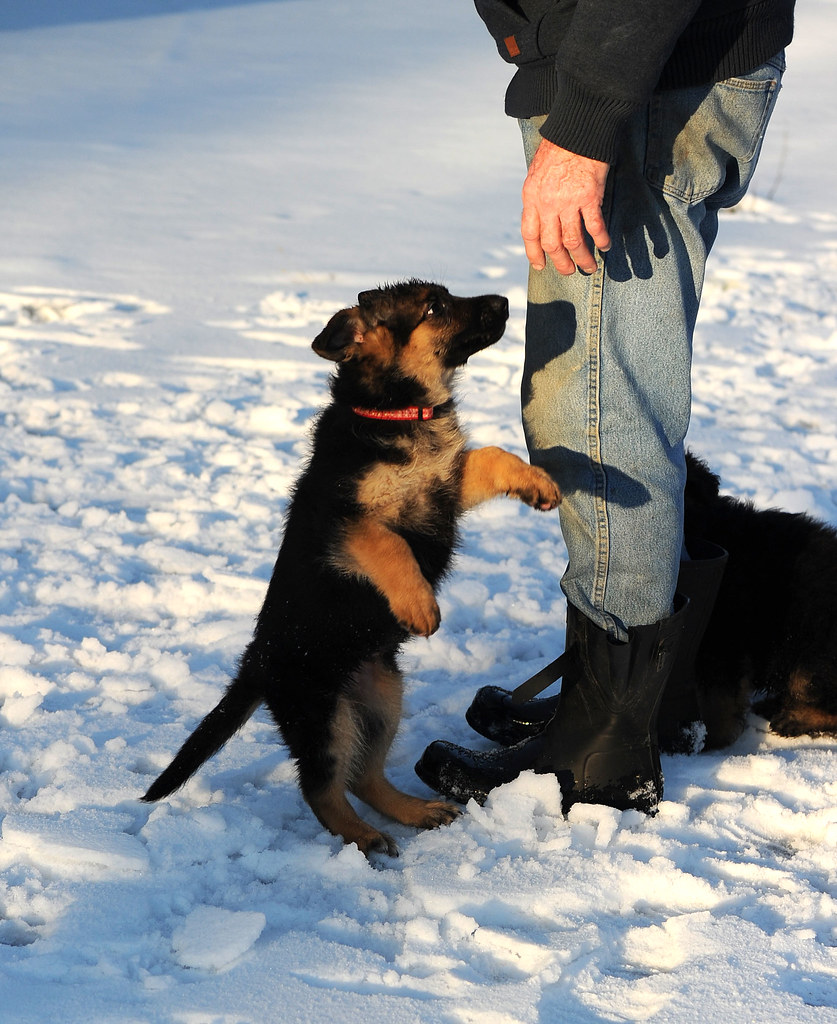
Entzückende Schäferhund Welpen
Overview
-
Sectors Development
-
Posted Jobs 0
-
Viewed 235
Company Description
The Ultimate Guide To German Shepherd Puppies
What You Should Know About German Shepherd Puppies
 German shepherd puppies are incredibly intelligent, easy to train and are natural workers. They are awe-inspiring and require plenty of exercise.
German shepherd puppies are incredibly intelligent, easy to train and are natural workers. They are awe-inspiring and require plenty of exercise.
Socialization at an early age is crucial to teach them that animals and humans do not pose threats. They can be afraid in situations that are not familiar to them.
Eyes
German Shepherds usually have brown eyes, however they may also have blue eyes. This is due to a genetic variation that requires both parents to carry the recessive gene to allow puppies to have blue eyes. However the color of a dog’s eyes is not a sign of the health of the dog.
In general, German Shepherds are very healthy and do not have any inherited illnesses that are related to their eye color. However, they may suffer from a variety of health issues that are common to all dogs. These include seizures and epilepsy, as well as bleeding disorders. These conditions can be prevented through preventive screening techniques.
While blue eyes are commonplace in other breeds of dogs, it’s rare to see them on a purebred German Shepherd. In reality, it’s often a sign that the puppy is not from a breeder who adheres to strict breeding standards and practices. Instead, it is likely that the puppy is mixed breed with a significant amount of Weimaraner or Siberian Husky in its ancestry.
It is not unusual for German Shepherds, despite being a rare mutation, to have one blue and one brown eye. This condition is referred to as heterochromia and can sometimes indicate that the dog has some health issue.
Another problem that is commonly encountered in German Shepherds is cataracts which are characterized by a lack of transparency on the cornea’s surface, or in the deeper corneal layers. These can lead to loss of sight or impair the ability to detect light. This can be easily prevented by restricting the amount of direct sunlight your German Shepherd is exposed to and encouraging it to spend as much time inside as possible. It can be treated with prescription medication or a specific pair of doggie sunglasses.
Ears
The German Shepherd is instantly recognizable by its pointed pinna and ears that are erect. The shape of the ears is determined by genetics. However, the environment and care can affect its appearance. If your pup’s ears seem to be floating or falling down, this is typical during the time of teething. The period typically lasts between 16 and 20 weeks. At that time, he’ll be able to keep his ears in place for a long time. The outer layer of skin on the ear and the inside cartilage is connected through muscles that allow it to move.
If you notice that your German Shepherd’s ear is always down, it could be a sign of an ear infection, or a physical trauma. Ear infections often cause a drooping ear, and symptoms can include itching, redness swelling, odor, or discharge from the affected ear.
Make sure you keep your German Shepherd’s ear clean to prevent ear infections. Bathing him too often could remove the natural oils that keep his ears healthy, so make sure to bathe him only as required. Avoid using any ear cleaning liquid more than two times per week. You can keep your dog’s ears moist by letting him soak his head in a bowl of water every now and then.
If one of your German Shepherd’s ears is being droopy, it could be due to an ear mite infestation. These tiny parasites are commonly found in the outdoors and can cause itching, irritation, swelling, and drooping in the affected ear.
Taping the ears of your German Shepherd with a tiny piece veterinary or medical tape will encourage them to stand. This can be done with the help of a professional dog trainer or vet, and many dogs will have their ears swollen within a matter of minutes after you tap them.
Coat
The German Shepherd Dog is a double-coated dog that has an undercoat that is soft and dense and a soft, fluffy undercoat. This breed sheds throughout the year and requires regular brushing to keep it looking the best. GSDs have an undercoat that is thick and soft, protecting the skin against the elements. The undercoat is adorned with longer guard hairs that are straight or curly. Guard hairs may be between two and four inches and can also include feathering on the ear, chest and bottom line and also on the back of the thighs. The long stock coat is reminiscent of the one with tufts on the ear and feathers at the feet. Plush coats are medium-length coats that are most often used in the show ring. They are a thicker and softer coat, with more feathering, compared to the stock coat.
The GSD comes in a broad variety of patterns and colors that range from the classic black and tan the majority of people know to other shades such as blues, fawns and livers. Another style that is very popular is the sable pattern. This pattern is comprised of lighter and darker hairs mixed together to create a wolf-like appearance on the entire body. Solid-color GSDs are also very common, as are GSDs with white markings.
The GSD was also renowned for its strength, agility and stealth. This made it a great police and military canine. Its intelligence and loyalty make it a wonderful family pet as well. German Shepherds are a large breed that is able to be protective of their families However, they are also calm enough to live happily with cats and dogs and also get along with livestock. GSDs are frequently trained in Schutzhund, a form of protection work that is designed to identify and deter criminal activity.
Weight
Puppy puppies are tiny and fragile when they are born. They rely completely on their mother for nutrition. Puppy’s are still small and have a limited appetite, reinrassiger deutscher schäferhund züchter (entzckendescferhundwelpen-wec35d.de) but they can increase their weight before the end of their neonatal phase.
A healthy German Shepherd puppy is alert, curious, and unafraid of making advances towards everything and anyone. They may play with the other littermates, but may also pick one or two of them to be the most dominant. These are typical of a well-bred pup.
When your puppy is about three weeks old, you may begin to feed him or her solid food items, such as raw ground beef. It’s usually a smooth transition. German Shepherd puppies are very quick to learn how to consume this food and generally, they are enthusiastic.
When your German Shepherd is four months old, the rapid growth will be over and he or she will be focused on gaining larger and developing adult teeth. Dogs who eat raw meat diet may be underweight, and you need to ensure that they’re getting enough calories.
A German Shepherd can develop hip and elbow dysplasia in the adult. They also are at risk of developing degenerative myelopathy which is a spinal cord disorder. Certain dogs might exhibit signs of these conditions, such as dragging their back feet or becoming unwilling to walk or jump up the stairs. Some dogs may have more than one illness and require treatment via medication, physical therapy or surgery.
Heart disease, particularly heart disease, such as dilated cardiomyopathy or valvular disorders that affect German Shepherds. These conditions can be evaluated by a vet using a stethoscope to listen to the dog’s chest, and x-rays.
Health
German Shepherds are at risk of certain health issues, such as hip dysplasia as well as degenerative myelopathy which can be made worse by genetic deficiencies, excessive exercise, and obesity. Purchase your German Shepherd from a responsible breeder and following a consistent eating schedule and a diet that avoids foods high in salt, fat or sugar can help to fight these problems.
The diet of a German Shepherd puppy should be rich in nutrients, and should contain ample protein and essential fatty acids. Puppies require as much as 10 percent fat in their diet to support their rapid growth and development. They also provide more energy than carbohydrates or proteins. The composition of fatty acids in the diet should consist of an amalgamation of omega-3 and omega-6 fatty acids from flaxseed, fish oils, and other vegetable sources.
Vaccinations are essential for the health of the German Shepherd puppy, especially against hepatitis and parvovirus. These vaccinations will also shield your pup from kennel cough and other respiratory diseases that can be caused by these illnesses.
A German Shepherd’s immune system is senile, and they are prone to allergies, specifically to flea bites and food. These can trigger stomach upset, weight loss, or vomiting. To prevent this from happening, feed a high-quality dog food that is easily digestible and avoid table food or human food as well as treats that are high in fat or sodium.
Cancer is another common concern for German Shepherds, specifically in older dogs. Hemangiosarcoma, a malignant tumor that develops in blood-rich organs such as the spleen and heart, is a common type of cancer seen in German Shepherds. Other cancers include intestinal, lung bone, and intestinal cancers. Lymphoma is yet another disease that can affect German Shepherds, especially multicentric lymphoma. This causes the growth of multiple lymph nodes within the body.
